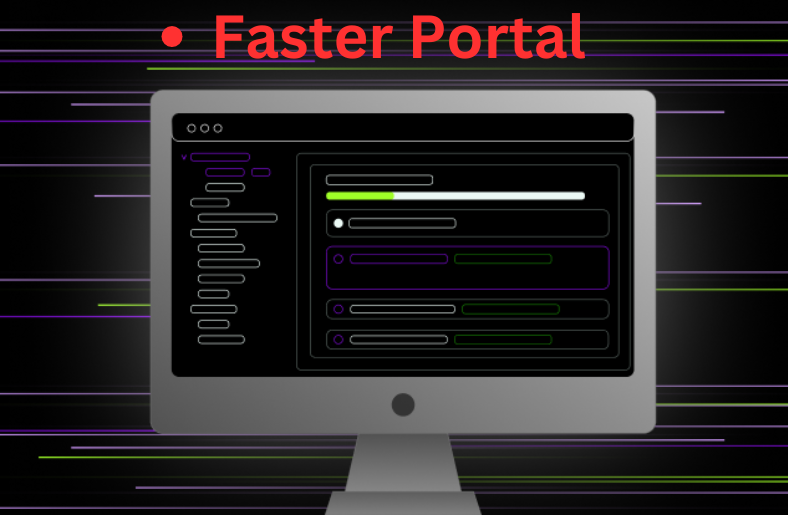
As in the case of any contemporary business operating in the digital world, speed is of the essence. As the business and individuals seek to achieve higher levels of efficiency the idea of a ‘Faster Portal’ comes into play. In this article, we examine the roles of Fasters in enhancing work processes and making entities more responsive and successful in various sectors.
Explaining the Concept of a Faster Portal
What is a Faster Portal?
A Faster Portal serves as more than just a gateway; it acts as a tool that provides users with quick access to the resources, information, or tools they need. Through reducing loading time and complexity, including necessary functions, these portals revolutionize the way individuals engage the displayed interfaces. Therefore, strategies for a Portal are not only relevant for an intranet in a large company, but they also apply to educational platforms and personal assistants.
The Need for Speed
The modern user is impatient. Studies have indicated that the least delay in the time taken for the websites to load causes a high number of people to abandon the site. More often in business settings, time lost is equivalent to money lost. Thus, a Faster Portal is not only a more convenient option for users; in addition, it produces even better engagement and retention compared to the current model.
To capture and maintain such speed, developers apply different tactics, including better server response, small file size, and CDN. All these technical enhancements enable the users to go through any information they want without any lot of delay.
Faster Portal: Key Features
- Intuitive Design
A Faster Portal outperforms in this factor with a clean User Interface. One can find what they need without having to go through so many subcategories. Accessibility, contrast, and pairwise labeling are components which play a significant role in enhancing the effectiveness of the interface.
- Advanced Search Capabilities
It is noteworthy that the definition of a Portal often implies fast accessibility of the sought information. Added features such as autocomplete and filters enable users to search for individual materials without much difficulty. This leads to time-saving in search of information and increase efficiency of work.
- Seamless Integration
Ideally, a Faster Portal must be connected in some way with other tools and platforms. Moreover, the single sign-on (SSO) and API support provided allow users to interface with various applications through a single entry point. Consequently, the integration described in this paper enhances efficiency and eases the burden on users.
- Real-Time Collaboration
In a world where knowledge work is becoming a more collective process, a Faster Portal supports synchronous communication. Customary elements like online chat, file sharing, and collaborative workspaces help teams coordinate effectively, even from afar.
- Mobile Accessibility
With the rise of remote work and mobile devices, having a Faster Portal accessible from various devices is essential. Responsive designs and mobile interfaces allow users to work on the go, increasing productivity whenever they access information.
Advantages of Executing A More Efficient Portal
It, however, means more than just being faster because it holds worthwhile benefits of being adopted as a Faster Portal. Organizations that prioritize this innovation can expect:
Increased Productivity
A Faster launches on thin-client operating systems and directly increases productivity levels because it accelerates the time taken to access information and tools. Its core clients can manage their business needs without worrying about inefficiencies they are not equipped to handle.
Enhanced User Satisfaction
It is clearly seen that the user satisfaction is directly dependent on the level of access. A Faster Portal enhances user experience and improves user retention. When users feel their needs are met, they spend more time on the platform and are likely to recommend it to others.
Cost Efficiency
It may take a good deal of time and money to establish a Faster, but the benefits are hard to dispute in the long run. Saving time and improvement in performance will always have a bigger impact on the financial bottom of any organization.
Competitive Advantage
In today’s competitive environment, any company that learns how to use a Faster Portal has tremendous competitive advantage over similar companies. They promote themselves as being at the operational and functional vanguard of their industries by boosting efficiency and user experience.
It is important as well to understand the future trends of faster portals as to its business implication.
The idea of Faster Portals will change as the technology progresses as well. Artificial intelligence (AI) and machine learning (ML) are transforming traditional methods. Incorporating these technologies will change how users engage with systems. Features like intelligent recommendations and insights-driven processing present new opportunities.
As secure and private web portals become standard, industry pressure will shift toward “Faster Portals.” These portals prioritize user security while enhancing speed. Organizations must integrate efficiency with strong security protocols to maintain user trust.
Conclusion
The purchase of a Portal is the purchase of success. Furthermore, markets and companies developing their own digital strategies face the challenge that, while potential exists, they will unlock it more slowly unless they keep access times and processes minimal. Ultimately, this change appears welcome for most people, especially when it leads to an increase in their working productivity.






I know this if off topic but I’m looking into starting my own weblog and was wondering what
all is required to get setup? I’m assuming having a blog like yours would cost a pretty
penny? I’m not very internet smart so I’m not 100% certain. Any recommendations or
advice would be greatly appreciated. Cheers